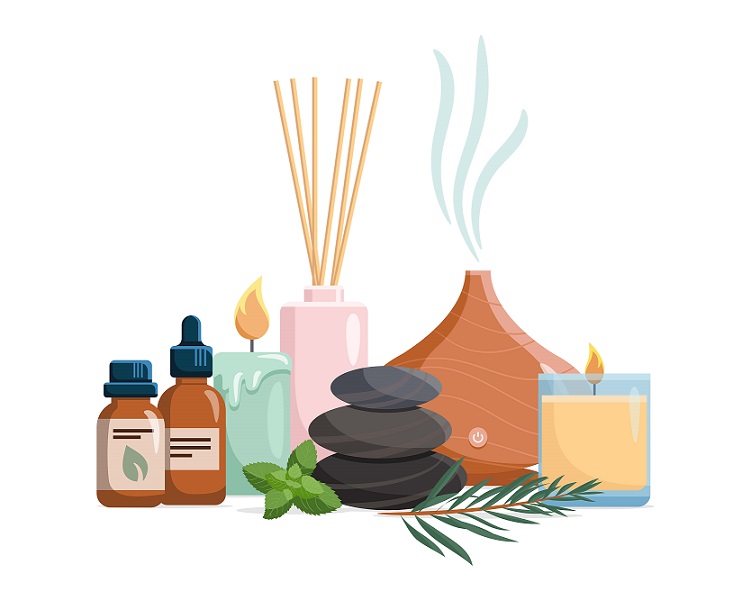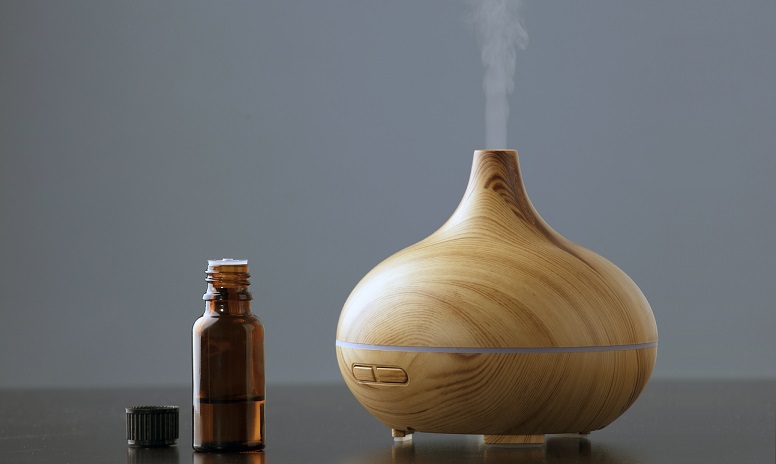Types Of Essential Oil Diffusers:
With many options to choose from, partly due to the growth of the essential oil market, it’s important to have an understanding of the different types of essential oil diffusers.
This will allow you to make a more sound selection in regards to what works best for your needs. However, if you have not read our original post on aromatherapy oil diffusers, head over there now.

We posted a while back on aromatherapy, and discussed the purpose of essential oils. Specifically, we touched on how essential oils are used within this holistic healing treatment.
There is not one “best way” to practice aromatherapy. However, sometimes the tools which you use, can make an enormous difference. This is where understanding your tools, like diffusers, comes into play.
Now, we’re going to begin talking about nebulizing essential oil diffusers. However this in no way in an order consistent with preference.
Aromatherapy Diffuser Types:
Nebulizing Diffusers:
Nebulizing Diffuser: How It Works?
These types of oil diffusers do not use or require heat, nor water, which may be a surprise to many.
So how do they work?
Nebulizing diffusers work by creating a forceful air current that moves through a small tube. From there, pressure is created, acting like suction, strong enough to cause the essential oil(s) added, to rise being dispersed as a fine mist.
Moreover, when you think nebulizing diffuser, think “force“. Moving forward, you’ll be able to note the difference from this type of operation, compared with the others.
Furthermore, what we believe makes this type of diffuser even more appealing, is there variety, aesthetics, and make-up.
Above all, may be the fact that they contain very low amounts (to zero) plastics in there designs. On top of that, because there is no water involved when dispersed, the oils are very concentrated when delivered into the atmosphere.
There are additional options you can find with nebulizing diffusers as well, like timers. Meaning they can disperse the vapors at specific times.
What to think about, includes:
- The dimensions of the room or office you wish to use the diffuser?
- Advanced features (timer? etc.)
- Noise level of the device?
- What’s the upkeep (cleaning), maintenance?
- How does it run (plug in?)
- Do you want it to be more portable or stationary?
Ultrasonic Essential Oil Diffuser:
Ultrasonic Diffuser: How It Works?
Similarly, how we think “force” with nebulizing diffusers, think “vibrations“, with ultrasonic versions of the diffuser.
Why is this the case?
Ultrasonic essential oil diffusers work by using vibrations to break down added oils into extremely small particles. The vibrations come from a small disc located below the oil/water mixture.
These particles are then dispersed into the air as a very fine mist with the help of steam.
With that said, the term “steam” usually means there is some sort of heat source, however ultrasonic diffusers don’t use heat. The process of creating a fine mist without the use of heat in this instance, is known as adiabatic process.

In simplest terms this means that no heat is gained or lost by the system.
Ultrasonic aromatherapy diffusers also come in a variety of shapes, sizes, and designs. Likewise, they are available at quite the varying price point depending on what exactly you’re looking for.
Besides the variety, there are a few important things to keep in mind with this type of diffuser.
- Uses a water/oil combination. Not pure essential oil.
- Uses plastic in many of the designs.
- Needs regularly maintenance to maximize longevity.
- Can serve a duel purpose as a humidifier. May work well in dry climates
- Very little noise created from these devices
Evaporative Essential Oil Diffusers:
Compared to the other essential oil diffusers, these here are probably the easiest ones to replicate, if you’re the crafty type.
Need a DIY project, these can really allow you to be creative!
The reed diffuser is an example of this type of aromatherapy diffuser. Rattan sticks are used in this case, placed in an essential oil and then the oils travel upward toward the top of the sticks, releasing the aroma.
Something to keep in mind with evaporative or reed essential oil diffusers is that they typically do no cover as large of an area as other diffusers. Furthermore, there tend to be less options available with less flexibility in usage.

A reed diffuser can be a great option for:
- a bathroom, powder room.
- small office.
- small bedroom.
- laundry room.
Another type of evaporative diffuser is one that uses a fan plus a filter or essential oil pad. The idea is to place a few drops of oil on the pad, in which the fan can then blow air through the “filter”.
The one downside is the rate at which the oils diffuse. We’ve also found the aroma’s don’t tend to last as long, then with other types of diffusers mentioned previously.
Make Your Own Reed Diffuser:
It’s important to note the oils used may alter some of the processes that take place with evaporative diffusers. The reason is, the lighter components of the oil will evaporate first, followed by heavier components.
Heat Essential Oil Diffuser:
Heat aromatherapy diffusers differ from other types because they use heat to help disperse the oils.
Like ultrasonic diffusers there is also a water plus oil mixture. The oils are still evaporating, however a heating element is added to help aid in the evaporation process.
Oftentimes this type of heating of oils, is a gradual process. It’s thought that if an element used it to hot, the chemical makeup of the essential oils can be compromised, thus changing the aroma.
One of the important aspects when choosing heat-based diffusers is to read reviews, and purchase from a reputable brand. However, this advice can be applied to buying any such item.
Candle (Type of Heat) Essential Oil Diffusers:
Candle + Ceramic Diffuser:
Technically, we could call this just a heat diffuser, since ultimately that’s what we’re using.
Essential oils are simply added above a lite candle. The heat of the candle then helps break the particles down, dispersing the aroma within a given space.
Again, like the evaporative diffusers, we find these work best in a smaller space, a space “essentially” more closed-in.
Final Thoughts!
When it comes to purchasing an essential oil diffuser, there is a lot to think about. Price, space, size of diffuser, maintenance, are just some of those things.
One of the most important aspects, however, is making sure to always follow manufacturers recommendations. These recommendations will change from type and brand. If you want longevity, you’ll want to make this a priority.
Once again, thanks again here from RN to Zen! We hope you check back with us again soon. Be sure to share our posts on your social media world.
If you have questions about any of out products be sure to use out contact us form and we’d be glad to assist.


